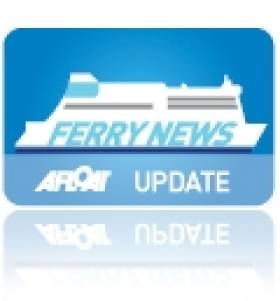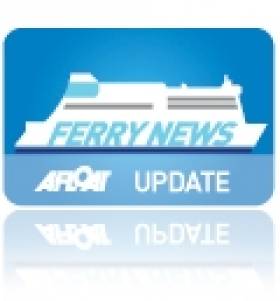Displaying items by tag: Isle of Man Steam Packet
#ferrycharter - Condor Ferries only conventional tonnage ferry on UK-Channel Islands service, Commodore Clipper recently resumed service before the English half-term break having spent over a month in dry dock in Cornwall, writes Jehan Ashmore.
Whilst Commodore Clipper was away on planned maintenance at A&P Falmouth, passenger services were maintained by fastcraft Condor Liberation. As for freight commitments they were covered by the chartered Manx registered Arrow, a ro-ro freight-only ferry.
The stern-loading Douglas registered Arrow is itself on charter from Seatruck Ferries, that acts as a relief ferry and backup support vessel for the Isle of Man Steam Packet Company. Their Ben-My-Chree (see Belfast and related Larne berthing trials stories) is a smaller version of Commodore Clipper.
The biennial dry-docking of Commodore Clipper included a £2.7m refit which was completed last week with resumption of scheduled overnight sailings from Guernsey (St. Peter Port) and Jersey (St. Helier) to Portsmouth with a daytime return.
The Arrow however currently remains serving the Channel Islands as Condor's freight-only ferry Commodore Goodwill entered dry dock last week for routine and remedial repair work.
As for the extensive work undertaken of the Commodore Clipper, this involved a major servicing of the ferry's port main engine and gearbox, ride control system, alternator and overhaul of the ship’s shaft seals. In addition life-saving equipment, monitoring and alarms systems were also repaired and upgraded.
Paul Luxon, Condor’s CEO, confirmed that the refit on 'Clipper' was part of a fleet-wide investment by the company to maintain lifeline services for the Islands.‘All of our ships require regular repairs and servicing for us to provide year-round freight and passenger operations and this is the order of £7.5 million annually. The work alone on Clipper, which is undertaken every other year, costs around £2.7 million. ‘
Mr Luxon added that passengers will also notice some improvements on board. ‘We have refurbished the lounge and restaurant and parts of the vessel will also be repainted. I am delighted that our recently launched Wi-Fi service will also be available on Clipper following installation of the necessary satellite equipment.’
Annually, Condor Ferries which asides UK routes also operates services to France, carries more than 1 million passengers and 200,000 passenger vehicles. The fleet carries 100,000 freight vehicles into the Channel Islands each year as well as exporting tonnes of local produce. As previously reported on Afloat, among such produce the 'Jersey' royal potatoes, see story.
Condor's second high-speed craft Condor Rapide in addition to the aforementioned freightferry Commodore Goodwill operates on the French service out of St. Malo, Brittany.
Future of Isle of Man ferry Services, Have Your Say
#SayOnFerry - TravelWatch, the UK passenger watchdog is urging the public to respond to a survey on the future of ferry services, writes IOMtoday.
Back in July, the independent group welcomed the Infrastructure Minister’s announcement in Tynwald that his department was to hold a public consultation on the future of ferry services.
A survey questionnaire was issued at the end of September, (closing date 9 Nov) seeking the views of passengers and freight users on issues such as preferred departure times and choice of ports in North West England and Ireland, and requesting the rating of items such as frequency of sailing, comfort and reliability of service.
TravelWatch says the tick-box format may be easier for the government to handle, but believes the public should be given an opportunity to make comments on whether the Steam Packet’s second vessel be a fast ferry or conventional ship.
For more on the story, click here.
Afloat.ie adds that the current conventional ferry the Ben-My-Chree (see captain interview) mostly serves on main Isle of Man-UK route between Douglas and Heysham.
Manx Fast-Craft Ferry Regains Full Power
#FastCraftRepaired – The Isle of Man Steam Packet's fast-craft, Manannan (1998/5,746grt) has returned to full power following repairs to one of its four engines was finally completed.
According to the operator's website, the Manannan is now operating on all four engines and back to its normal schedule. The Tasmanian built 96m wave-piercing catamaran from the yard of InCat, normally serves her main route between Douglas and Liverpool.
As previously reported in July, she had a suffered a failed crankshaft with one of its four engines.
The incident that took place at the height of the summer season was not at option for the Steam-Packet to take Manannan out of service. Otherwise this would of led to several days to carry out the repairs resulting in huge disruption for passengers.
Instead, the Manx based operator announced a revised schedule allowing for slightly longer journey times, so travellers could plan ahead. This allowed a committment of additional resources to be carried out in repairing the vessel while staying in port overnight.
Annual Mid-Summer Round Isle of Man Sunset Cruise
#IsleofManCruise- The annual Round the Island Sunset Cruise is to take place next Saturday (28 June) and operated by the Isle of Man Steam Packet's ro-pax Ben-my-Chree.
The main ship of the Manx ferry company, Ben-My-Chree which was featured in the ferry captain interviews series will depart Douglas at 1900 for a trip of around 4 hours. Tickets are on sale, priced at £26 for adults and £16 for children, including a main meal, non-alcoholic drink and ice cream.
The bar will not be open during the sailing as the vessel is not licenced to sell alcohol while it is in Manx waters. However, passengers are welcome to 'bring their own' to enjoy with their meal.
Chief Executive Mark Woodward said: 'These cruises are a wonderful opportunity to appreciate the beauty of the Manx coastline and enjoy a relaxing evening in good company. They are always popular, so I'd recommend booking early to avoid disappointment.
'Once again this year, the very knowledgeable Captain Stephen Carter will be providing commentary during the journey, which provides a fascinating insight to go with the breathtaking views.
To book a place on the Ben-my-Chree round-the-Island cruise, call in person at the Ferry Travel Shop, Sea Terminal, Douglas or call the Reservations Team on 661661. For more information in general about island ferry connections visit: www.steam-packet.com
Final Manx-Dublin Seasonal Service Sailings
#ISLE OF MAN FERRY – This weekend will see the final round-trip of seasonal Douglas-Dublin sailings operated by the Isle of Man Steam Packet Company.
The ro-pax ferry Ben-My-Chree is scheduled to depart Douglas tomorrow evening at 19.30hrs with an arrival in Dublin Port on (Sunday30 December) just after midnight at 00.15hrs.
The ferry will make her return departure to the Isle of Man, departing Dublin Ferryport at 01.00hrs with an arrival at the Manx capital scheduled for 05.45hrs.
For sailing schedules including Manx-UK routes, click HERE.































































